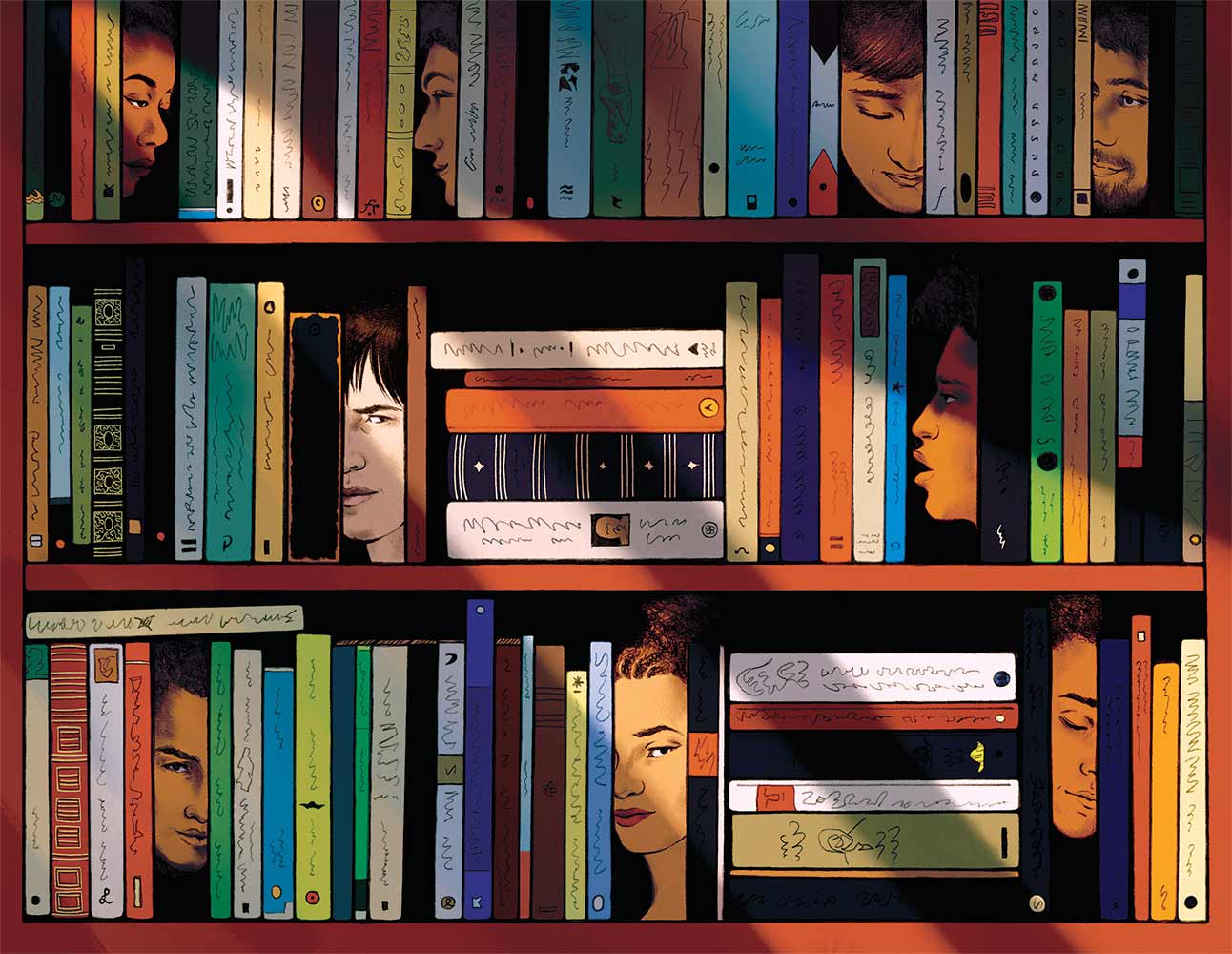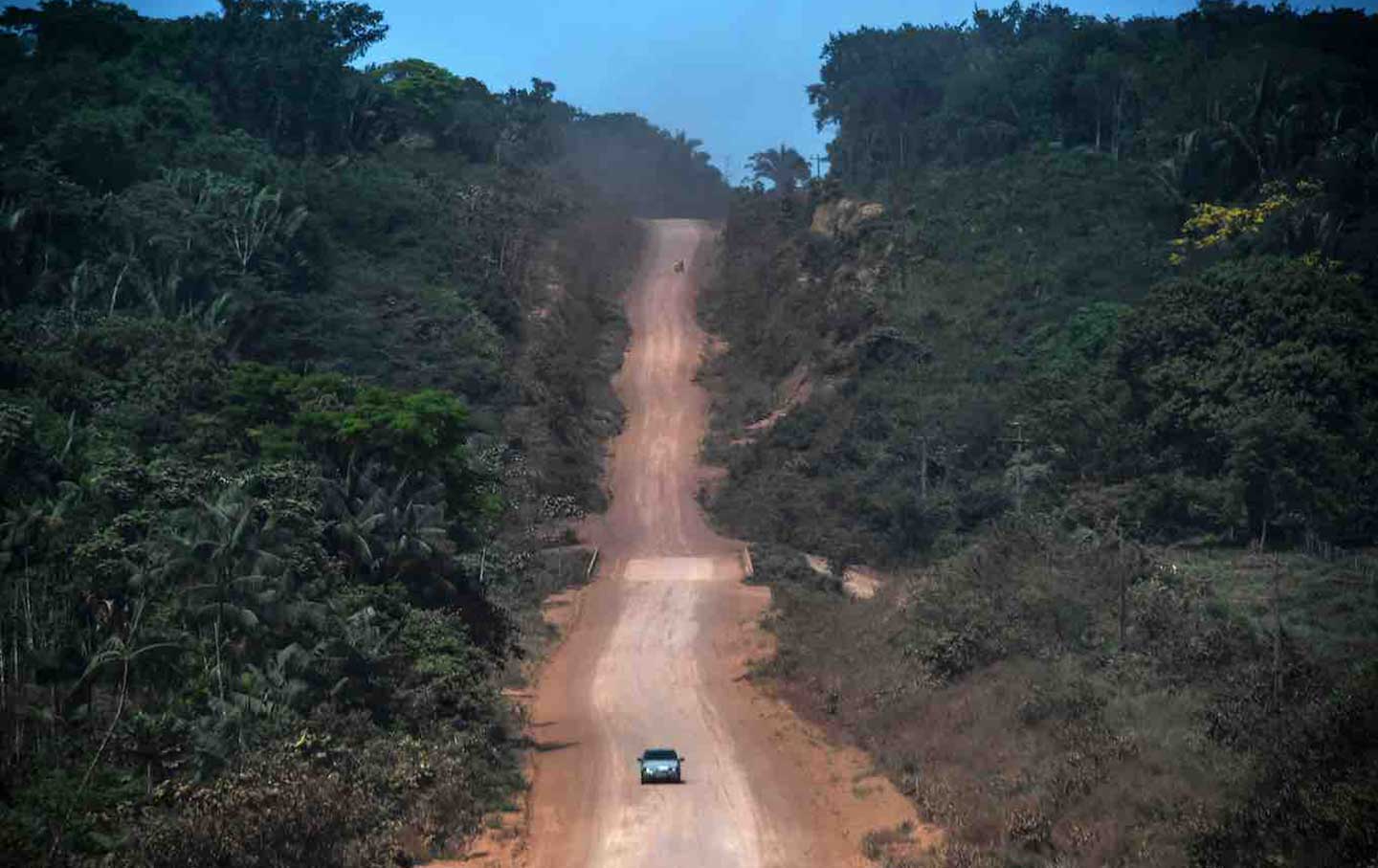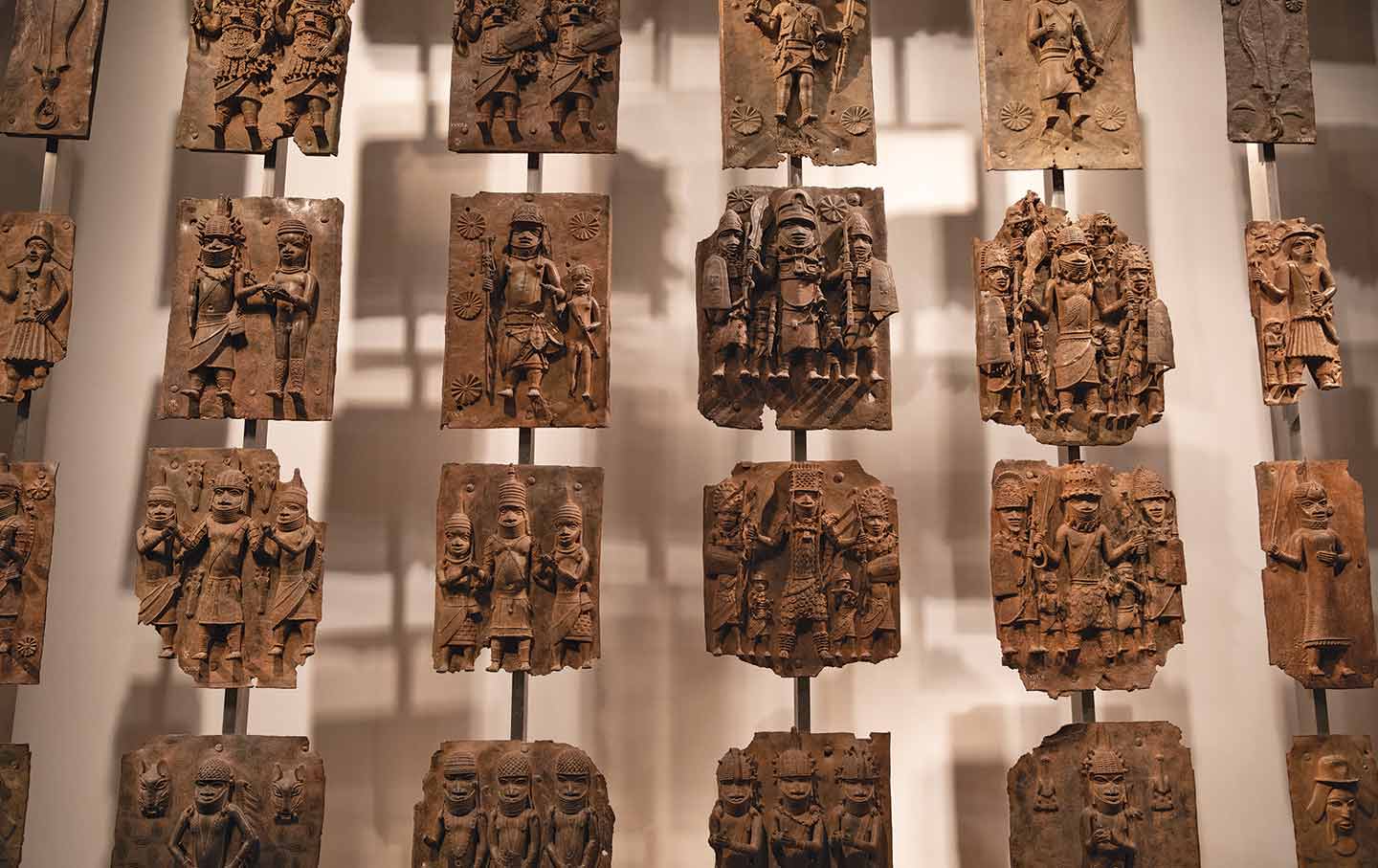Friends and Lovers
Brandon Taylor’s fiction of class and campuses.
Brandon Taylor’s Sweeping Novel of Class and Campuses
The Late Americans works the way that university towns do. People move in, move out, move on—not everyone gets to meet, but everyone temporarily occupies the same spaces.

In his review of Sally Rooney’s Beautiful World, Where Are You?, which appeared in The New York Times in 2021, the writer Brandon Taylor took a certain tendency in contemporary fiction to task. In the growing body of novels about the panic and precarity of 21st-century life, Taylor noted, the central characters—often middle-class white women—talk fretfully about “their privilege and access to capital” as a stand-in for an “actual class critique.” But, he wondered, “is that enough?”
Books in review
The Late Americans: A Novel
Buy this bookWhen it came to Rooney’s novel, Taylor had his doubts. He wasn’t convinced that Beautiful World had successfully converted the chatty despair of its small cast of charismatic characters into an “actual consideration” of the social and economic roles they occupied, though he did acknowledge that the novel at least made a “charming” if “also frustrating” attempt to do so. But the larger question in Taylor’s review remains: What does it mean for a novel to engage in actual class critique today? The 19th- and early-20th-century fiction that largely occupies his thinking as a critic—novels by Émile Zola, Henry James, and Edith Wharton, among others—peer into the social roles of a multitude of characters to consider the minute gradations and degradations of class. One might say that the kind of contemporary novel that Taylor interrogates in his review, with its tight focus on “the tableaux of feeling overwhelmed” in the quotidian lives of individual protagonists, does the opposite.
Ironically, Taylor’s debut novel, Real Life, proved to be similarly evasive in its engagement with class. A work of campus fiction set in a prestigious, primarily white biology department, it sketched the network of racial, sexual, and economic tensions that formed the background to the story of its protagonist, Wallace, a gay Black graduate student. But much of the novel’s class analysis was eclipsed by the workings of Wallace’s immediate emotional responses to the world around him; Real Life hewed closely to his perspective alone.
Taylor’s new novel, The Late Americans, however, takes on the challenge of telling the multiple stories of a larger social milieu in scattered yet granular detail. Set at the University of Iowa, it follows an academic year in the life of young people living in Iowa City, students and otherwise, as they grapple not only with their own privileges and access to capital but also with the absence of both in the lives of those around them. Here we get a finely detailed, even pointillistic portrait of class and the ways it can make and unmake human relationships. Shifting from one point of view to the next, the novel also breaks out of the cloistered perspective of a single protagonist and examines how a slew of characters notice (and just as often fail to notice) their class positions. The dynamism of the novel comes from its movement between these characters but also from its ability to see past them to the social structures that organize so much of their lives. As in the big, sweeping novels of Zola, James, and Wharton, bit by bit the reader comes to see the larger systems that these characters are bound up with, either by choice or circumstance, and the way these systems make them who they are.
The novel’s shape is deceptively simple: Each chapter of The Late Americans focuses on a different character, observed through a limited omniscient third-person perspective. The narrative’s focus bounces gently from one person to the next via social contact. We get incisive one-line sketches of several MFA students specializing in poetry—Beth, Helen, Noli, Mika, and Linda—before realizing that their classmate Seamus is the first of our central characters. We then skip to Fyodor, whom Seamus meets at a bar, and his boyfriend, Timo, then leapfrog again over Timo’s friend Goran to his boyfriend, Ivan, and via Ivan to a cohort of dance students. While many of these characters are separated by class, education, and identity, they are also connected—often unpredictably so—through the bars and coffee shops, the shared passions, and the planned and unplanned proximity created by a small Midwestern college town.
Appropriately, we are introduced to Seamus by way of one of the more familiar set pieces in fiction set at the University of Iowa: a horrendously uncomfortable seminar in the Writers’ Workshop. Seamus is a gay, white, Ivy League–educated man who rolls his eyes at invocations of personal trauma and intentionally enrages his fellow students with his response to the poem being discussed. Yet even if he is one of those guys, once we follow him out of the classroom, we learn that much of his performed privilege is just that: an act. Seamus comes from a working-class family marked by the traumas of sexual and emotional abuse. This is information that he resists sharing with his peers; instead, he trolls them. “I’m triggered by your insults,” he taunts his classmates, even as he hints at how vulnerable he is. “They remind me of my torturous childhood. Please stop.”
To make ends meet, Seamus has a job working at a hospice, and it is there that we begin to see another side of him. Speaking to Bert, a local man whose cruel father is dying there, Seamus feels that, if anything, he is the one with an advantage, and so he experiences “some of that old Marxist guilt. The reflexive pity and shame of being a little better off than a person to whom he was speaking.”
Seamus’s “reflexive pity and shame” are aggravatingly clear to Bert, who views him as just another elitist college kid. Yet as they speak, Seamus learns that Bert, whose father owns the land on which they’re standing, is financially more stable than he is. Class cuts in many contradictory ways, and Seamus tries to make sense of his swift movement in and out of his various social positions. One can, he concludes, “simultaneously [occupy] two systems then. How strange these networks of human relation.” These networks are made even stranger and more convoluted by a terrifyingly brutal eruption of violence between the two men.
But just as we begin to know Seamus, Taylor quickly pivots to another life. (He is, after all, trying to paint a many-figured mural rather than a single portrait.) Yet he chooses not one of the more predictable characters—Bert, perhaps, or one of the poetry students—but instead Fyodor, the man who briefly chats with Seamus at a bar. Fyodor is a townie, a worker at a meatpacking plant who is in an on-again, off-again relationship with Timo, a grad student in mathematics. Fyodor and Timo are initially drawn together by their commonalities—both are mixed-race gay men—but their relationship is constantly challenged by reminders of the differences that exist within what they share: Timo comes from a successful professional family that lacks the cushion of generational wealth that some of his peers have. Yet though he is constantly aware of money as a problem, it is not in the acute, pragmatic way that Fyodor is. When Timo complains about Fyodor’s job, citing the “morally indefensible” nature of killing and eating animals, Fyodor replies, “This is what my life is. You think that this will be temporary, but it isn’t. This is what my life is. What I will be.” Timo cannot comprehend the starkness of Fyodor’s frustrated declaration or understand what experiences could motivate it. Like Seamus and Bert, the two men are never fully visible to each other.
The movement from one character to the next does not always have a clear social logic: We travel from lover to friend to near stranger, often getting to know just enough about a character to start to wonder about them once they’re almost entirely gone from view. Sometimes we loop back and encounter the same person again; sometimes we meet someone we wish we could know better but only ever see in passing; and sometimes we linger with someone who doesn’t seem to fit in at all.
In this regard, The Late Americans works the way that university towns do. People move in, move out, move on—not everyone gets to meet, but everyone temporarily occupies the same spaces. But in the background is also the wider social system—in particular, the financial and cultural pressures that some face and others do not. One person doesn’t need a first job, let alone a second; another is conspicuously worried about their landlord raising the rent; while a third is wracked with anxiety about making enough money to send home to their parents. Graduate school begins with the origin myth that everyone is a poor student, pulled together by the same idealistic and heady desire to learn more about the world and about one another. But as the semesters pass, students have to confront the dawning understanding that some of them are from wealthy backgrounds while others are not, and all manner of stealthy avoidance tactics become necessary to keep the illusion of shared enterprise intact.
Throughout The Late Americans, Taylor is especially concerned with the way that the more privileged among his student characters naively assume an equality of opportunities and resources. This misapprehension is clearest in the relationship between Ivan and Goran, whom we meet three chapters into the novel, and who weave in and out of sight until the end. Ivan, the son of Russian immigrants living in Boston, is in the final year of work on his MBA, after which he hopes to get a finance job in New York or San Francisco. Ivan is also a former dancer, forced by an injury to quit the pursuit of an art he loves. Goran, a pianist and a graduate student in music, simply cannot understand Ivan’s financially motivated choices, especially when he discovers that Ivan has been earning money by posting artful pornographic video clips online. But Goran is not painted simply as an annoyingly innocent wealthy person; his and Ivan’s relationship is also complicated by the fact that he is the Black adopted son of a rich white family. Ivan, who is white, cannot grasp how Goran’s Blackness affects the way that he himself, or the world at large, views him; all Ivan can see is Goran’s economic position rather than his race. The “networks of human relation” that Seamus puzzles over grow more and more tangled with every character we meet.
Popular
“swipe left below to view more authors”Swipe →The novel depicts these episodes of often unspoken misperception with alternating tones of sadness, humor, frustration, and optimism. But Taylor is doing something else too: He is offering us a portrait of the different kinds of work that take place in a college town. From the beginning, when we see Seamus move directly from the institutional scene of artistic work to one of paid employment, we are asked to view these types of work simultaneously: In an academic milieu—and in the campus novel—the work of producing art and scholarship often trumps any other concern, such as money, time, material need, or even the work that students are required to take up to get by. (Another version of this novel might have focused on PhD students rather than MFA students, which would have forced Taylor to also wrestle with the labor issues of graduate students employed by a university.)
Nowhere are the blurring boundaries between these two types of work clearer than in a group of dancers that we meet in the book’s last sections. Noah, an Iowa native, works in construction when he’s not in the dance studio, while Fatima alternates between shifts at a local coffee shop and long hours of rehearsal. She bears the brunt of this social pressure to demonstrate a wholehearted commitment to dance, no doubt because she is a woman (one of only two we get to know in the novel), subject to the sexist demands still made upon female dancers; the other students resent the demands of her hourly wage work, seeing it as a mark of both greater and lesser dedication to their shared art.”But this is the real work,” a classmate tells her. To which Fatima responds: “I don’t know what you mean. It’s all work, you know. Work, work, work.”
As the reader comes to the end of The Late Americans, having zigzagged between characters and social settings, one realizes that perhaps a better question to ask of this novel is not whether its depiction of class is enough, but whether it’s too much. By dipping in and out of so many different lives and relationships, does The Late Americans take on too big a task? Constrained only by the temporal limits of the school year, the book could still go on forever, skipping from one small galaxy within the universe of the big state school to the next. What’s more, unlike most campus fiction, the university does not serve as a boundary for the novel. Yet The Late Americans seems to anticipate this question; at times when the reader expects a narrowing of perspective, the novel takes a sudden, wider turn.
The most jarring of these happens in a late chapter in which we meet Bea, Noah’s neighbor. She is a disconnected, isolated character, not of interest to the grad students moving in and out of the rest of the novel. Shifting from Noah’s perspective to hers, we see Bea notice him, and though Noah must notice her, too, he shows no sign of it. Yet when they pass each other one day, Noah suddenly waves, and Bea waves back. For a fleeting moment, this simple sign of recognition feels tremendous to this largely invisible woman, and Bea “felt her place in the world’s great calculating machine shift slightly.” In a novel of misperceptions and misunderstandings, the scene stands out. For Bea, it is temporarily transformative: To be observed and recognized is an event in what she feels to be her eventless life. “It is enough,” Bea thinks, echoing a line—whether or not she intends the allusion, Taylor clearly does—from Virginia Woolf’s To the Lighthouse.
In Woolf’s novel, the words are exclaimed inwardly by Mrs. Ramsey. As she watches the beam of the lighthouse sweep over the sea at dusk, “the ecstasy burst in her eyes and waves of pure delight raced over the floor of her mind and she felt, It is enough! It is enough!” But Bea’s neutral, even resigned phrasing makes clear the hard limit of this reference; certainly there are no exclamation marks. Taylor’s Americans are too late for the epiphanic rhapsodies of modern fiction. The title itself, with its grandly gloomy take on James, suggests a kind of fatigue—of the realist novel, perhaps, or of late capitalism, or of the idea that revelation itself is possible.
The novel offers an acknowledgment of this tiredness while still depicting the need to go on despite it. Our ways of being and of creating and of working are tired, and the task of reevaluating our received notions of class and race and gender and privilege feels unending. The novel of social critique is still with us, but in this case, its aim is not to rouse protest or deliver scathing criticism, but to reveal our exhaustion in beautifully exacting detail and with an intensity of consideration and tenderness.
We may never get to see these characters fully understand or even directly confront their complicated entanglements in the social worlds they move through, but The Late Americans reminds us that sometimes, even the briefest recognition can be enough.
More from The Nation

The Agony of Aaron Rodgers The Agony of Aaron Rodgers
Is he the world’s most interesting athlete or is he just a washed-up crackpot?

Can You Understand Ireland Through One Family’s Terrible Secret? Can You Understand Ireland Through One Family’s Terrible Secret?
In Missing Persons, Clair Wills's intimate story of institutionalized Irish women and children, shows how a family's history and a nation’s history run in parallel.

Peter Schjeldahl’s Pleasure Principle Peter Schjeldahl’s Pleasure Principle
His art criticism fixated on the narcissism of the entire enterprise. But over six decades, his work proved that a critic could be an artist too.

How the Western Literary Canon Made the World Worse How the Western Literary Canon Made the World Worse
A talk with Dionne Brand about her recent book, Salvage, which looks at how the classic texts of Anglo-American fiction helped abet the crimes of capitalism, colonialism, and more...

Along the Roads That Built Modern Brazil Along the Roads That Built Modern Brazil
José Henrique Bortoluci's What Is Mine tells the story of his country’s laborers, like his father, who built its infrastructure, and in turn its fractious politics.

The Long History of the "Elsewhere Museum" The Long History of the "Elsewhere Museum"
Can the ethnographic museum be reinvented?


